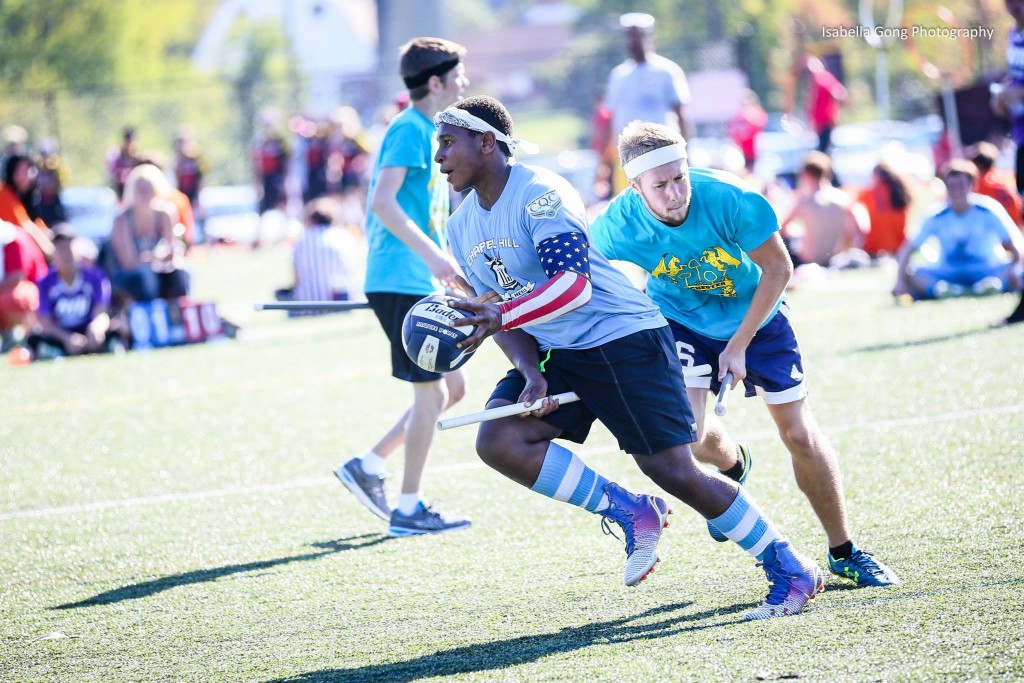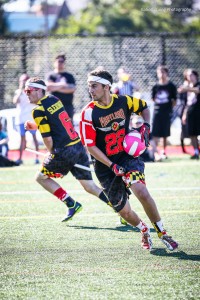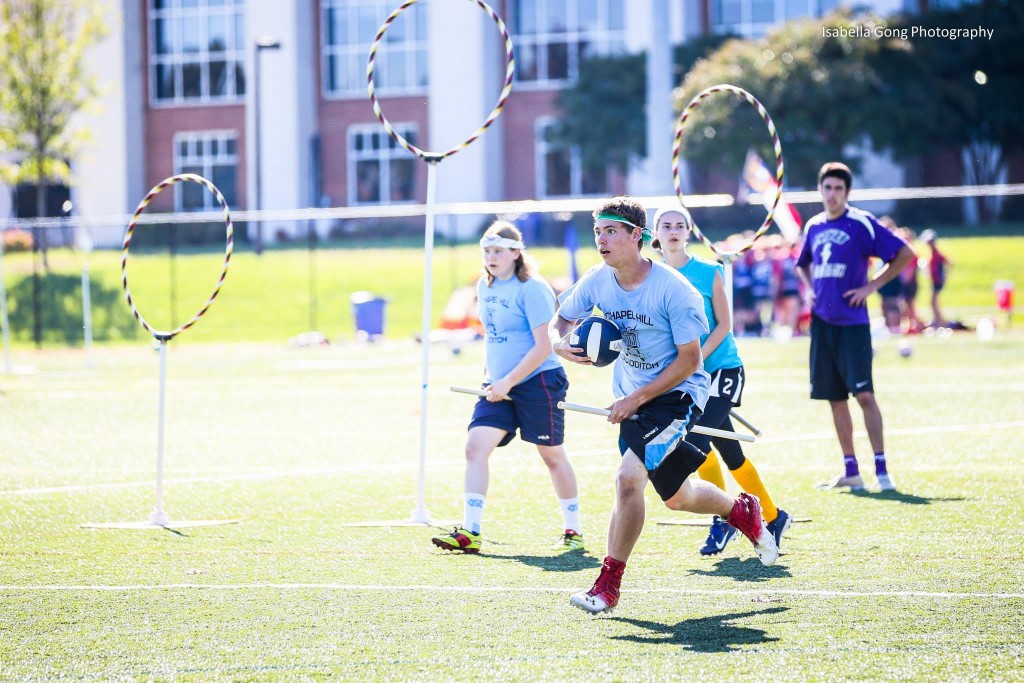Antwerp QC, Much of Belgian Core, Leaves Competitive Quidditch

Credit: Isabella Gong
After such an exciting opening weekend to the season, the follow-up was pretty uninteresting. There was a total of one ranked team in action this weekend, and they did exactly what was expected of them, avoiding a single snitch-range game in seven matches.
So what is a writer tasked with putting out a couple thousand words about the sport at the beginning of week to do? Why, write about his logistical pet peeve of the week, of course.
(For those of you that prefer to live in oblivion of the shortcomings of our sport’s management—and honestly, I don’t blame you—you can skip to actual on-field analysis starting under the first bolded header.)
This weekend, I was lucky enough to have the opportunity to travel to Turtle Cup. Our car included three certified head referees and two people who were kind enough to offer up their weekend to help make sure the filming of the event went smoothly. What I literally did not realize until Saturday was that, had we not come, one of the country’s marquee tournaments probably would have been unofficial.
The state of refereeing in quidditch is currently in a very scary place. Two weeks into the season, there have been two major official tournaments—Tournament of the Stars II in the Midwest and Turtle Cup in the Mid-Atlantic. Both took small miracles to become official. For Tournament of the Stars, it required the last minute commitment of two out-of-region referees to travel and a sketchy, unannounced policy change from USQ that allowed referees that had provisionally passed their field test to continue refereeing for the rest of the day, even though they could end up being failed in the end by the higher ups in the USQ’s refereeing pyramid.
Turtle Cup, at least, was a bit more straightforward: it only required three people, who just so happened to be some of the lucky few to actually get field tested at a fantasy tournament, all agreeing to travel eight hours just to referee.
This all could have been avoided if USQ had either mobilized their refereeing plans earlier or simply caved and allowed IRDP to run its refereeing. Instead, we have a mysterious body of referee coordinators—the list of whom is known to very few people (RAC are listed below)—that came together too late, missing golden opportunities for field testing at many major fantasy tournaments and leaving the roster of head referees very sparse.
RAC: Brandon Kreines, Clay Dockery, Dan Hanson, Samy Mousa,
Alex Wilson, Eric Schnier and Ricky Nelson
The USQ has some promise. Each week means more and more head referees tested. The monetary bump for refereeing makes long travel more realistic, and the new crop of referee coordinators seems to really be interested in making sure those who pass deserve to do so. But it is hard not to wonder if it is too little too late. The first two major tournaments of the season have somehow gotten by, but what will next week, the busiest week of the season so far, bring? For everyone’s sake, we can only hope it will bring more miracles.
Alright, that is enough morbidity, time to talk week two: three storylines, two tournaments, one elite team. Let’s do it.
Turtle on Pace
The University of Maryland was put under a microscope this weekend. The Terrapins were forced to play their first tournament of the season under the eyes of the entire nation and were expected to absolutely decimate the competition, with any hiccup likely leading to droves of undeserved criticism. A lesser team may have crumbled under the pressure or at least struggled. Maryland is not a lesser team.

Credit: Isabella Gong
To be ranked the number three team in the country is a lot of praise; it is saying that the Terrapins are right up there with the best of the Southwest teams. And, even against this watered-down competition, the qualities that earned them that distinction shone bright this weekend.
The first thing that jumps out about you is their depth. Maryland plays 21-players deep without any drop off in talent. Not only that, but every chaser and every beater offers up their own style and talents, making game planning even more difficult. Your defense needs to ready to handle Harry Greenhouse’s passes, Steve Sleasman’s catch-and-releases, Bryan Barrows’ speed, Erin Mallory’s cuts, Josh Marks’ bulldozing and the list goes on and on. Late on Saturday, someone turned to me and asked if I was sure they were only playing 21 players. It sure felt like they had a lot more.
The depth even extends to the seeking game. While Greenhouse is the best known, Steve Gambino had a phenomenal weekend, making multiple grabs in under 15 seconds. Throw in Chris Thomas as a change-of-pace seeker, and you have a three-headed monster that forced multiple teams into defending the snitch with their only beater, even though they had to try to get back into snitch range.
While the offense was still adjusting to the many styles the team is capable of running out onto the field, the defense was on point throughout, allowing just 17 quaffle points per game over the course of the tournament, including three shutouts. The primary reason for that was their man-marking, which regularly took every passing option out of entire possessions thanks to the team’s superior athleticism. Mix that with a one-bludger defense that used a beater as a point defender, and the Terrapins were capable of snuffing out many attacks near midfield. When they could not, they had the skill and confidence throughout the entire roster to hit hard and consistently, making even no-bludger drives incredibly difficult.
The only time the team looked anything but elite all day was the first half of their match with the University of Virginia, in which they only led 20-0 twelve minutes into the game, mainly due to the dominating play of Virginia beater Brian Stanley. But even watching that game, you never felt that the result was truly in doubt. Virginia never really got close to scoring, all but completely shut down by the Terrapins’ defense. And when the offense clicked, as it was sure to do eventually, Maryland still took the game down comfortably.
Aside from those 12 minutes—and I’m comfortable giving a team a 12-minute pass at their first tournament—Maryland earned an A-plus. They pulled out of snitch range of Villanova for the first time in the history of the match-up, allowing just 30 points, and showed the value of their depth by wearing UNC down to submission in the finals. The terrapins will be tested more—they will face better teams, and they still have some work to do honing their beater strategy—but for one week at least, their ranking seems well-deserved.
Quasi-Coronation
Saturday was supposed to be a coronation. The reign of LSU in the state of Louisiana had finally reached its close, the result of a mass exodus of the team’s best players, and Loyola (New Orleans) was touted as being better than ever, more than ready to take the Tigers’ spot. But at the Crawfish Classic, things did not quite go as planned for Loyola. What was supposed to be a coronation became a dogfight.
It seemed like everything had gone right for Loyola in the off season. None of LSU’s key players chose to return, while Loyola got another year of development from the likes of Etefia Umana and Tad Walters, while also absorbing some talented players from the surrounding area, including Emerson College graduate CJ Junior.
But the first test run for Louisiana’s new world order did not go as expected. Loyola started the day by needing a snitch grab to beat Tulane, who they were trailing in quaffle points, and ended the day with a 90*-80 loss to that pesky LSU side. While they did get the tournament win, it was a hollow one, earned on point differential after bracket play had to be called off.
If “Best in State” was a title belt, Loyola would not have even managed to take it this weekend, but technically and statistically, it will be the title they will hold for now. Still, with multiple missing pieces this past weekend, including Junior, and many young players still being integrated, we have yet to see the best the team has to offer. Which is good, because with too many weekends of results like this, the entire state could be relegated to quidditch oblivion sooner rather than later.
Tumultuous Tar Heel
UNC has not been on a hype train so far this season, they have been on a hype roller coaster. They started the offseason as so many people’s sneaky second-best team in the Mid-Atlantic that it stopped being sneaky, then looked so disinterested and impotent at Minerva Cup that everyone, myself included, got on their back. They then proceeded to start their Turtle Cup by falling behind Rutgers University, 30-0, early in the game. But from there, the Tar Heels were stellar, putting up a pool play point differential that topped even Maryland’s before making a run to the finals, where they finally fell, 150*-60, to the Terrapins.
It is hard to talk about UNC without talking about Max Miceli, but for the most part, that is what we are going to do here today. Miceli remained the team’s most potent scorer throughout the tournament, but he rightfully gave his other players time in blowout. pool-play contests and was forced into limited playing time in the finals by severe cramps in his legs.
But with Miceli leaving some space in the spotlight over the weekend, and with Chris Champitto not in attendance, there was space for a pair of other players to shine. The first was Justin Cole, a freshman quaffle player who injected a level of athleticism the team tended to lack behind its stars. He was a contributor on both offense and defense—where he was a plenty physical presence for a new player—and should help to fill out their first line going forward.

Credit: Isabella Gong
While Cole undoubtedly played well, it was a full-on breakout tournament for beater Kyle Bullins. Over the course of the day, Bullins was aggressive in all the right ways, whether it was making it impossible for Capital Madness to leave their keeper zone; keeping bludger control from Kyle Jeon for large chunks of time; or keeping Maryland from just running away with the finals, despite barely being able to stand. He mixes a strong arm with very impressive catching ability, and I believe he will only improve over time. Which is good, because if UNC wants to be the poor man’s LSU and Miceli is going to be Brad Armentor, Bullins is going to need to be both Daniel DePaula and Jason Winn.
As good as UNC looked on Saturday, glaring weaknesses remain. The team has no depth, which was more than evident as they tried to go blow-for-blow with a far deeper Maryland team in the finals. They also play no defense, a combination of a lack of athleticism in their depth and just a poor team defensive mentality that starts at the top with Miceli, who is not known for his defensive effort. These might not be glaring issues against Rutgers and Madness, but they will be against better teams.
So have the Tar Heels earned the title of the Mid-Atlantic’s second best team going into October? At the moment, I would have to say they have, but watching both them and Villanova play, I fear that moment may be fleeting. Villanova has the athletic depth that UNC lacks and are likely to make that click offensively sooner rather than later. The Mid-Atlantic Regional Championship is only a month away, but unless the bracket breaks in a friendly way for the Tar Heels, I think they will be on the outside looking in come the final.
Archives by Month:
- May 2023
- April 2023
- April 2022
- January 2021
- October 2020
- September 2020
- July 2020
- May 2020
- April 2020
- March 2020
- February 2020
- January 2020
- December 2019
- November 2019
- October 2019
- August 2019
- April 2019
- March 2019
- February 2019
- January 2019
- November 2018
- October 2018
- September 2018
- August 2018
- July 2018
- June 2018
- April 2018
- March 2018
- February 2018
- January 2018
- November 2017
- October 2017
- July 2017
- June 2017
- May 2017
- April 2017
- March 2017
- February 2017
- January 2017
- December 2016
- November 2016
- October 2016
- September 2016
- August 2016
- July 2016
- June 2016
- May 2016
- April 2016
- March 2016
- February 2016
- January 2016
- December 2015
- November 2015
- October 2015
- September 2015
- August 2015
- July 2015
- June 2015
- May 2015
- April 2015
- March 2015
- February 2015
- January 2015
- December 2014
- November 2014
- October 2014
- September 2014
- August 2014
- July 2014
- May 2014
- April 2014
- March 2014
- February 2014
- January 2014
- November 2013
- October 2013
- September 2013
- August 2013
- July 2013
- June 2013
- May 2013
- April 2013
- March 2013
- February 2013
- January 2013
- December 2012
- November 2012
- October 2012
Archives by Subject:
- Categories
- Awards
- College/Community Split
- Column
- Community Teams
- Countdown to Columbia
- DIY
- Drills
- Elo Rankings
- Fantasy Fantasy Tournaments
- Game & Tournament Reports
- General
- History Of
- International
- IQA World Cup
- Major League Quidditch
- March Madness
- Matches of the Decade
- Monday Water Cooler
- News
- Positional Strategy
- Press Release
- Profiles
- Quidditch Australia
- Rankings Wrap-Up
- Referees
- Rock Hill Roll Call
- Rules and Policy
- Statistic
- Strategy
- Team Management
- Team USA
- The Pitch
- The Quidditch Lens
- Top 10 College
- Top 10 Community
- Top 20
- Uncategorized
- US Quarantine Cup
- US Quidditch Cup
